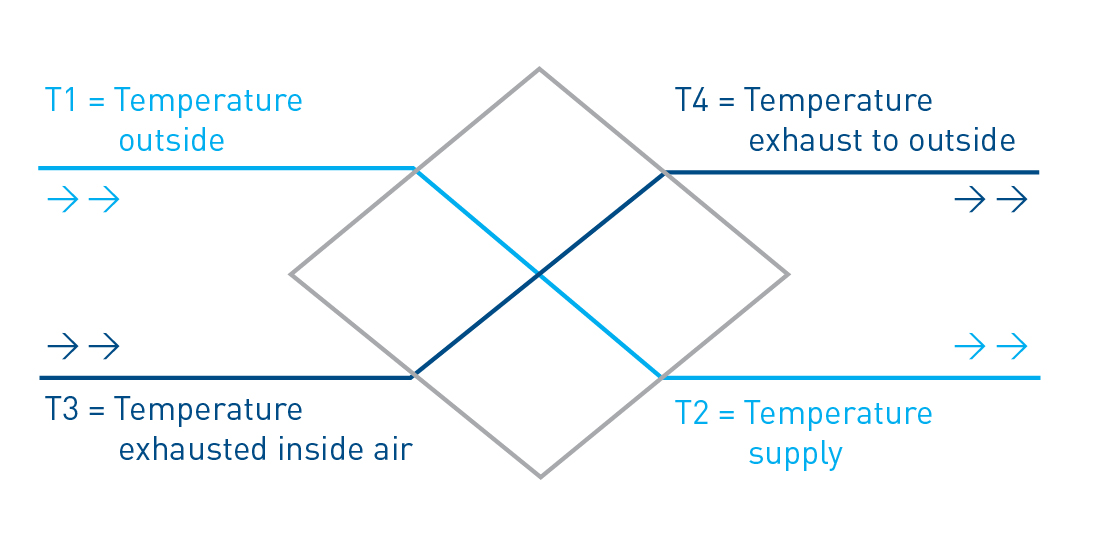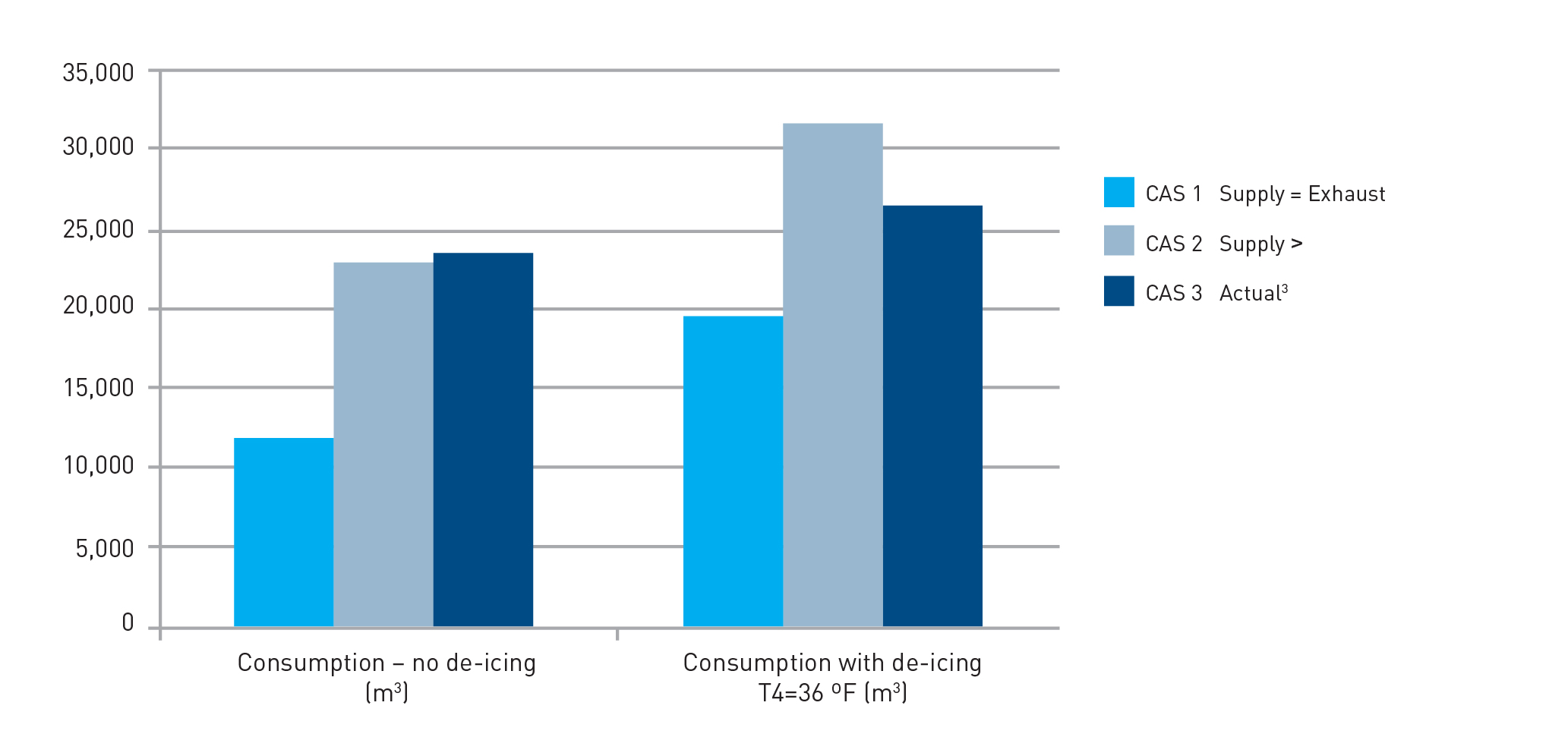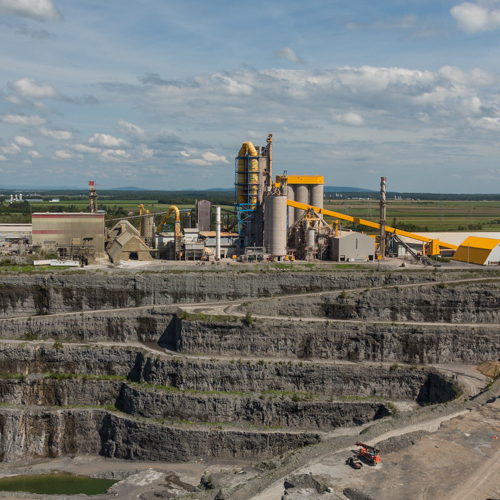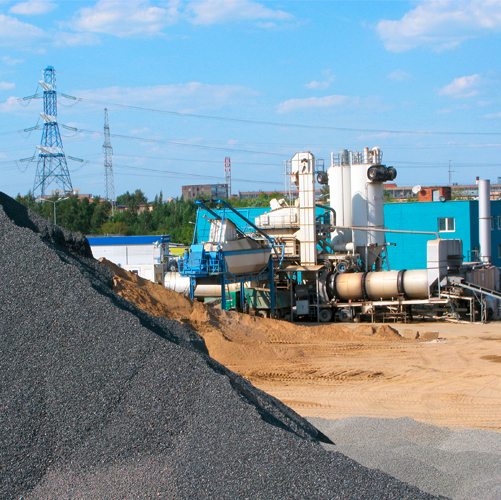The primary goal of a heat recovery unit in a North American climate is to minimize the cost of heating fresh air.
In a cold climate, operations may be carried out below the freezing point. To protect operations and avoid complications, freeze-prevention methods are used, which reduce system efficiency.
These prevention methods may thus have an impact on overall heating consumption and on operating costs.
Performance and climatic conditions
Throughout the winter, energy recovery is done by exchanging heat from the warm fluid (the stale air from the building) toward the cold fluid (outside air introduced). A good design must take into account the possibility of ice build-up on the airflow side, which loses heat during cold winter temperatures. In this regard, the at-risk side is the stale air side.
Thermal exchange diagram

The formation of ice on a heat exchanger reduces the exchange surface. The flow of air required by the building may thus be reduced, as well as the efficiency of the recovery system. Also, the condensate needs to be drained when it defrosts or when it remains in its liquid form.
There are several methods for preventing icing. The main ones are:
- Preheating the air on entry and on exit
- Adding a by-pass passage on the air supply or the air exhaust path
- Setting pre-determined defrosting cycles
- Controlling the temperature of the exhaust air as it exits the exchanger toward the outside
- Varying the speed of rotation in the case of a thermal wheel
- Using the difference in air flow rates between supply and exhaust
Overall, these methods are able to give an acceptable average temperature at the exchanger exit, on the exhaust side. According to the manufacturers and the heat recovery unit specifications, the recommended temperatures vary between 33°F (1°C) and 36°F (2°C).
The actual temperature on the contact surface of the exchanger is not necessarily uniform over the whole surface. In fact, ice accumulations are possible at certain points on the surface when the temperature is below 32°F (0°C). Since we are using an average temperature, the reading precision becomes even more important, which explains the different temperatures recommended by manufacturers.
Consumption and conditions
For a given thermal wheel, certified AHRI, two (2) parameters will be evaluated under three (3) different conditions in order to evaluate actual consumption:
Parameters:
- Energy consumption with recovery, without de-icing
- Energy consumption with de-icing at T4 = 36°F (2°C) to simulate a more realistic and safe operation
Conditions:
- CASE 1 (EQUAL): 10,000 ft3/min (same supply and exhaust flow rates)
- CASE 2 (SUPPLY >): 10,000 ft3/min at supply and 7,500 ft3/min at exhaust
- CASE 3 (EXHAUST >): 7,500 ft3/min at supply and 10,000 ft3/min at exhaust
Results
In all cases, heating efficiency was set at 90%. The efficiency of the heat exchanger-recuperator is related to the parameters shown in the following table. Since the cost of natural gas is not fixed over time, an average cost of $0.50/m³ has been used to simplify the calculations.
| Comparison of consumption results | |||||
| Energy recovery with exchanger1 | |||||
| CASE 1 | CASE 2 | CASE 32 | |||
| Supp. = Exh | Supply > | Exhaust > | Neg.3 | Actual4 | |
| Flow – Supply (ft3/min) | 10,000 | 10,000 | 7,500 | 2,500 | 10,000 |
| Flow – Exhaust (ft3/min) | 10,000 | 7,500 | 10,000 | 0 | 10,000 |
| Consumption – no de-icing (m3) | 11,700 | 22,900 | 3,700 | 19,600 | 23,300 |
| Consumption with de-icing T4=36 °F (m3) | 19,500 | 31,700 | 6,700 | 19,600 | 26,300 |
| Diference in consumption (m3) | 7,800 | 8,800 | 3,000 | 0 | 3,000 |
| Cost of consumpton – no de-icing | $5,850 | $11,450 | $1,850 | $9,800 | $11,650 |
| Cost of consumption with de-icing | $9,750 | $15,850 | $3,350 | $9,800 | $13,150 |
| Direct extra cost ($) | $3,900 | $4,400 | $1,500 | 0 | $1,500 |
| Extra cost vs. Equal flows ($) | $0 | $6,100 | $-6,400 | $9,800 | $3,400 |
| Total extra cost ($) |
$3,900 |
$10,500 |
$-4,900 | $9,800 | $4,900 |
| Efficiency – Nominal recovery (% Eff.) | 80.2% | 88.7% | 88.7% | 0.0% | 66.5% |
| Seasonal efficiency Deg. T4=36 °F (% Eff.) | 75.1% | 59.6% | 88.6% | 0.0% | 66.5% |
Note: Values calculated based on parameters provided. Efficiency takes mass flows into account.
Eff. = (mS/mM) x (T1-T2) / (T1-T3) Eff. = (mE/mM) x (T4-T3) / (T1-T3)
CASE 1: Equal flow rates of 10,000 ft3/min (nominal)
Gives a nominal recovery efficiency of 80% and a seasonal efficiency of 75%. The extra cost with de-icing mode is $3,900.
CASE 2: Supply flow rate 25% greater than exhaust (supply = 10,000 ft3/min; exhaust = 7,500 ft3/min)
Gives an apparent nominal efficiency greater than for the same equal flow recuperator (89% vs. 80%) and a seasonal efficiency of 60%, a 30% difference. The extra cost with de-icing mode is $10,500.
Note: This situation may occur more often than desired; for example, when all the exhaust air cannot be collected at the same location.
CASE 3: Supply flow rate 25% lower than exhaust (supply = 7,500 ft3/min; exhaust =10,000 ft3/min)
Since the exhaust flow rate is higher than supply, the building will have negative pressure unless another system makes up the difference.
For comparison purposes, the calculations will use the hypothesis that the difference in flows in the building will be made up by other means and will be heated locally at the inlet points by a conventional heating system with the same efficiency as the one paired with the recovery system. The building will thus be subject to neutral pressure.
We thus have an apparent nominal efficiency greater for the same recuperator (89% vs. 80%) and an actual seasonal efficiency of 66%, when taking into account the portion of the total flow that does not go through the recovery system. The extra cost with de-icing is $4,900.
Conclusion
As can be seen, the evaluation of consumption with no de-icing versus with de-icing may give significant differences in consumption.
For a specific heat recovery system, the apparent efficiency is directly related to the total energy available from the mass flow differences.
An equal flow rate between supply and exhaust would seem preferable in order to recover the maximum energy from the mass flows involved.
A higher supply flow rate should not be used if the building is to maintain positive pressure, or if it is not cost-effective, or impossible, to amass an equivalent exhaust flow rate.
A higher exhaust flow rate may be acceptable if the building is maintained with a slightly negative pressure. In this case, the building must be sufficiently airtight, since air will seek to infiltrate to make up the loss and will be heated finally by a conventional system, thereby not optimizing the capacities of an energy recovery system. Since the mass flow rate is higher at the exhaust, the icing limit risk can be pushed a little lower and thus a little more energy can be recovered. However, as indicated earlier, the building needs to be airtight to benefit from such an advantage, not to mention the potential problems of operating a building with negative pressure (for example, doors more difficult to open or a chimney backdraft.)
After all these observations, a rather cold climate undeniably influences energy consumption due to the cycles of de-icing required on energy recovery systems.
Richard Meunier, Eng., CEM
Consultant, Energy Efficiency Technologies
DATECH Group
- Innergy tech – I3-MS3A-108.
- Case 3 assumes that an internal neutral pressure is desired for the building.
- Case 3 assumes that the portion of air not treated by the recovery system to bring it to a neutral pressure, is admitted by other means, and thus heated indirectly without energy recovery on that portion.
- Combined consumption values in Case 3, taking into account the portion recovered and that made up indirectly.
References:
- Winnergy software, Version 3.2, Innergy tech
- AHRI 1060-2005
- ASHRAE 84-91 Standard
- Environment Canada – Climate normals in Canada 1971-2000 for Montréal
- ASHRAE Handbook 2012 – HVAC Systems and Equipment, Ch. 26
Continue reading









